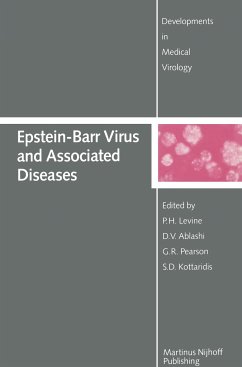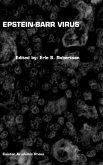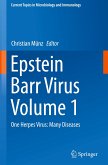Epstein-Barr Virus and Associated Diseases
Proceedings of the First International Symposium on Epstein-Barr Virus-Associated Malignant Diseases (Loutraki, Greece¿September 24¿28, 1984)
Herausgegeben:Levine, P. H.; Ablashi, D. V.; Pearson, G. R.; Kottaridis, S. D.
Epstein-Barr Virus and Associated Diseases
Proceedings of the First International Symposium on Epstein-Barr Virus-Associated Malignant Diseases (Loutraki, Greece¿September 24¿28, 1984)
Herausgegeben:Levine, P. H.; Ablashi, D. V.; Pearson, G. R.; Kottaridis, S. D.
- Broschiertes Buch
- Merkliste
- Auf die Merkliste
- Bewerten Bewerten
- Teilen
- Produkt teilen
- Produkterinnerung
- Produkterinnerung
It has been slightly more than two decades since the Epstein-Barr virus (EBV) was discovered by Prof. M.A. Epstein and his colleagues at the University of Bristol in their search for the causative agent of Burkitt's lymphoma. For several years EBV was a "virus in search of a disease." The first documentation that EBV was pathogenic for humans was in 1969 when Drs. Gertrude and Werner Henle identified it as the causative agent for infectious mononucleosis. Seroepidemiologic and biochemical studies subsequently linked EBV to Burkitt's lymphoma (BL), nasopharyngeal carcinoma (NPC), and more…mehr
Andere Kunden interessierten sich auch für
![Epstein-Barr Virus and Human Cancer Epstein-Barr Virus and Human Cancer]() Epstein-Barr Virus and Human Cancer39,99 €
Epstein-Barr Virus and Human Cancer39,99 €![Dendritic Cells and Virus Infection Dendritic Cells and Virus Infection]() Dendritic Cells and Virus Infection149,99 €
Dendritic Cells and Virus Infection149,99 €![Epstein-Barr Virus Epstein-Barr Virus]() Epstein-Barr Virus288,99 €
Epstein-Barr Virus288,99 €![Human Papillomavirus and Epstein-Barr Virus in Male genital Tract Human Papillomavirus and Epstein-Barr Virus in Male genital Tract]() Silvia CavalcantiHuman Papillomavirus and Epstein-Barr Virus in Male genital Tract36,99 €
Silvia CavalcantiHuman Papillomavirus and Epstein-Barr Virus in Male genital Tract36,99 €![Epstein-Barr Virus Epstein-Barr Virus]() Epstein-Barr Virus233,99 €
Epstein-Barr Virus233,99 €![Epstein Barr Virus Volume 1 Epstein Barr Virus Volume 1]() Epstein Barr Virus Volume 1112,99 €
Epstein Barr Virus Volume 1112,99 €![Epstein-Barr Virus and Human Disease · 1990 Epstein-Barr Virus and Human Disease · 1990]() Epstein-Barr Virus and Human Disease · 1990115,99 €
Epstein-Barr Virus and Human Disease · 1990115,99 €-
-
-
It has been slightly more than two decades since the Epstein-Barr virus (EBV) was discovered by Prof. M.A. Epstein and his colleagues at the University of Bristol in their search for the causative agent of Burkitt's lymphoma. For several years EBV was a "virus in search of a disease." The first documentation that EBV was pathogenic for humans was in 1969 when Drs. Gertrude and Werner Henle identified it as the causative agent for infectious mononucleosis. Seroepidemiologic and biochemical studies subsequently linked EBV to Burkitt's lymphoma (BL), nasopharyngeal carcinoma (NPC), and more recently to the X-linked lymphoproliferative syndrome. With its widespread pattern of infection and a predilection for producing clinical signs and symptoms in only certain individuals, EBV has provided a model for many other candidate oncogenic viruses, including papilloma viruses, herpes simplex, and HTLV/LAV. In 1975, an international workshop was sponsored by the National Cancer Institute to address the problem of EBV production, thus facilitating basic research on the virus. This proved to be the last international meeting on EBV for almost a decade. In the past, progress in both clinical and basic research on EBV has been presented in two types of international meetings, the international herpesvirus workshops devoted primarily to basic research on both human and animal herpesviruses, and the international symposia on NPC, in which EBV-related studies were interspersed with clinical, epidemiologic and other etiologic aspects of this important human neoplasm.
Produktdetails
- Produktdetails
- Developments in Medical Virology 1
- Verlag: Springer / Springer US / Springer, Berlin
- Artikelnr. des Verlages: 978-1-4612-9641-6
- Softcover reprint of the original 1st ed. 1985
- Seitenzahl: 712
- Erscheinungstermin: 5. Oktober 2011
- Englisch
- Abmessung: 235mm x 155mm x 38mm
- Gewicht: 1060g
- ISBN-13: 9781461296416
- ISBN-10: 1461296412
- Artikelnr.: 39679325
- Herstellerkennzeichnung Die Herstellerinformationen sind derzeit nicht verfügbar.
- Developments in Medical Virology 1
- Verlag: Springer / Springer US / Springer, Berlin
- Artikelnr. des Verlages: 978-1-4612-9641-6
- Softcover reprint of the original 1st ed. 1985
- Seitenzahl: 712
- Erscheinungstermin: 5. Oktober 2011
- Englisch
- Abmessung: 235mm x 155mm x 38mm
- Gewicht: 1060g
- ISBN-13: 9781461296416
- ISBN-10: 1461296412
- Artikelnr.: 39679325
- Herstellerkennzeichnung Die Herstellerinformationen sind derzeit nicht verfügbar.
Immunodeficiency Diseases.- 1. Association of Epstein-Barr Virus and Lymphoproliferative Diseases in Immune Deficient Persons.- 2. Relapsing, Recurrent and Chronic Infectious Mononucleosis in the Normal Host.- 3. Immune Assessment of Patients with Chronic Active EBV Infection (CAEBV).- 4. Reversal of Common Variable Hypogammaglobulinemia-Associated Suppressor Cell Activity by Specific Carbohydrates.- 5. Unusual Primary Tumors of Brain and Lungs Associated with Epstein-Barr Virus (EBV).- 6. Lytic, Non-Transforming Epstein-Barr Virus (EBV) from Two Patients with Chronic Active EBV Infection.- 7. Brief Communication: The Significance of Antibodies Against the Epstein-Barr Virus-Specific Membrane Antigen gp250 in Acute and Latent EBV Infections.- EBV-Associated Malignancies.- 8. The Epidemiology of Epstein-Barr Virus-Associated Malignancies.- 9. Genetic Aspects of EBV-Associated Malignancies.- 10. Pathology of Epstein-Barr Virus (EBV)-Associated Disease (the Lymphatic System).- 11. The "Family Study" Approach to Investigating the Role of Genetic Factors in Nasopharyngeal Carcinoma.- 12. An EBV-Associated Salivary Gland Cancer.- 13. Nasopharyngeal Carcinoma: Early Detection and IgA-Related pre-NPC Condition. Achievements and Prospectives.- 14. Evaluation of Epstein-Barr Virus Serologic Analysis in North American Patients with Nasopharyngeal Carcinoma and in Comparison Groups.- 15. Use of Epstein-Barr Virus Serology in the Diagnosis of Nasopharyngeal Carcinoma in Malaysia.- 16. An Analysis of the Relationship Between Clinical Pathology and Serological Level of EB Virus VCA-IgA Antibody in Nasopharyngeal Carcinoma.- 17. Brief Communication: Fossa of Rosenmuller: The Site for Initial Development of Carcinoma of the Nasopharynx.- 18. Brief Communication: Carcino-EmbryonicAntigen (CEA) in Nasopharyngeal Carcinoma and Chronic Nasopharyngitis.- 19. Brief Communication: HLA-Antigens in NPC Patients from a Low-Risk Area (Cologne, FRG).- Molecular Biology of EBV.- 20. Persistence and Expression of the Epstein-Barr Virus Genome in Latent Infection and Growth Transformation of Lymphocytes.- 21. An Epstein-Barr Virus-Determined Nuclear Antigen Encoded by a Region within the EcoRI A Fragment of the Viral Genome.- 22. An EBV RNA with a Repetitive Spliced Structure.- 23. Characterization of an EBV-Associated Protein Kinase.- 24. Characterization of the Genes within the BamH1 Fragment of Epstein-Barr Virus DNA that may Determine the Fate of Viral Infection.- 25. Effects of Tunicamycin on Binding of Epstein-Barr Virus.- 26. Brief Communication: Structure and Expression of the Epstein-Barr Virus Genome.- 27. Brief Communication: Antibody Response to Epstein-Barr Virus-Specific DNase in Thirteen Patients with Nasopharyngeal Carcinoma.- 28. Brief Communication: Recent Developments in Nucleic Hybridization.- Mechanisms of EBV Transformation.- 29. The Host-Cell Range of the Epstein-Barr Virus.- 30. Epstein-Barr Virus (EBV) Growth Transformation is Associated with an Alteration in C-MYC Chromatin Structure.- 31. Study of Nucleosomal Organization of Chromatin in EBV Producer and Non-Producer Cells.- 32. Novel Biological Functions Associated with Epstein-Barr Virus DNA.- 33. EBV DNA Content and Expression in Nasopharyngeal Carcinoma.- 34. Transformation of Human Lymphocytes by Coinfection with EBV DNA and Transformation-Defective Virions.- 35. Epstein-Barr Virus-Activating Substance(s) from Soil.- 36. Hydrocortisone Enhancement of both EBV Replication and Transformation of Human Cord Lymphocytes.- 37. Brief Communication: Detection of EBNA and Rescue of Transforming EBV in Megakaryocyte Cells Established in Culture.- EBV Proteins.- 38. Advances in the Identification of EBV-Specific Proteins: An Overview.- 39. Bacterially Synthesized EBNA as a Reagent for Enzyme Linked Immunosorbent Assays.- 40. Epstein-Barr Virus Nuclear Antigen (EBNA): Antigenicity of the Molecule Encoded by the BamH1 K Fragment of the EBV Genome.- 41. The Use of Antibodies Against Synthetic Peptides for Studying the EBV Nuclear Antigen.- 42. Characterization of Two Forms of the 72,000 MW EBNA and a Cross-Reacting Cellular Protein.- 43. Identification of EBV-Specific Antigens Following Micro-injection of Subgenomic DNA Fragments.- 44. Localization of Epstein-Barr Virus Early Antigen (EA) by Electron Microscopy.- 45. Selection and Production by Genetechnological Methods of Medically Relevant EBV-related Antigens.- 46. Identification of Multiple Epstein-Barr Virus Nuclear Antigens.- 47. Brief Communication: Production of Human Monoclonal Antibodies by EBV Immortalization.- Immunology.- 48. Cellular Immunity in EBV Infections.- 49. T Cell Responses to Epstein-Barr Virus Infection.- 50. Epstein-Barr Virus and Immunosuppression.- 51. In Vitro Immunogenicity of Human Lymphoid Tumour Cell Lines.- 52. Monocyte Contrasuppression of EBV-Immune Regulatory T Cells.- 53. Analysis of Intratumoral Lymphocyte Subsets in Patients with Undifferentiated Nasopharyngeal Carcinoma.- 54. Potential Usefulness of Isoprinosine as an Immunostimulating Agent in EBV-Associated Disorders: In Vitro Studies.- 55. Mechanisms of Expression of a Burkitt Lymphoma-Associated Antigen (Globotriaosylceramide) in Burkitt Lymphoma and Lymphoblastoid Cell Lines.- Control of EBV-Associated Malignant Disease.- 56. Prevention of EB Virus-Associated Malignant Diseases.- 57. A Perspective on Treatmentof EBV Infection States 619.- 58. Clinical and Pathobiological Features of Burkitt's Lymphoma and their Relevance to Treatment.- 59. Management of Nasopharyngeal Carcinoma.- 60. Treatment of Nasopharyngeal Carcinoma with the Antiviral Drug 9-[(2-Hydroxyethoxymethyl)] Guanine: A Case Report.- 61. EBV-specific Transfer Factor in the Treatment of African Burkitt's Lymphoma: A Pilot Study.- 62. Brief Communication: The Teatment of Nasopharyngeal Carcinoma (NPC).- Special Lecture.- 63. Epstein-Barr Virus: Past, Present and Future.- List of Participants.
Immunodeficiency Diseases.- 1. Association of Epstein-Barr Virus and Lymphoproliferative Diseases in Immune Deficient Persons.- 2. Relapsing, Recurrent and Chronic Infectious Mononucleosis in the Normal Host.- 3. Immune Assessment of Patients with Chronic Active EBV Infection (CAEBV).- 4. Reversal of Common Variable Hypogammaglobulinemia-Associated Suppressor Cell Activity by Specific Carbohydrates.- 5. Unusual Primary Tumors of Brain and Lungs Associated with Epstein-Barr Virus (EBV).- 6. Lytic, Non-Transforming Epstein-Barr Virus (EBV) from Two Patients with Chronic Active EBV Infection.- 7. Brief Communication: The Significance of Antibodies Against the Epstein-Barr Virus-Specific Membrane Antigen gp250 in Acute and Latent EBV Infections.- EBV-Associated Malignancies.- 8. The Epidemiology of Epstein-Barr Virus-Associated Malignancies.- 9. Genetic Aspects of EBV-Associated Malignancies.- 10. Pathology of Epstein-Barr Virus (EBV)-Associated Disease (the Lymphatic System).- 11. The "Family Study" Approach to Investigating the Role of Genetic Factors in Nasopharyngeal Carcinoma.- 12. An EBV-Associated Salivary Gland Cancer.- 13. Nasopharyngeal Carcinoma: Early Detection and IgA-Related pre-NPC Condition. Achievements and Prospectives.- 14. Evaluation of Epstein-Barr Virus Serologic Analysis in North American Patients with Nasopharyngeal Carcinoma and in Comparison Groups.- 15. Use of Epstein-Barr Virus Serology in the Diagnosis of Nasopharyngeal Carcinoma in Malaysia.- 16. An Analysis of the Relationship Between Clinical Pathology and Serological Level of EB Virus VCA-IgA Antibody in Nasopharyngeal Carcinoma.- 17. Brief Communication: Fossa of Rosenmuller: The Site for Initial Development of Carcinoma of the Nasopharynx.- 18. Brief Communication: Carcino-EmbryonicAntigen (CEA) in Nasopharyngeal Carcinoma and Chronic Nasopharyngitis.- 19. Brief Communication: HLA-Antigens in NPC Patients from a Low-Risk Area (Cologne, FRG).- Molecular Biology of EBV.- 20. Persistence and Expression of the Epstein-Barr Virus Genome in Latent Infection and Growth Transformation of Lymphocytes.- 21. An Epstein-Barr Virus-Determined Nuclear Antigen Encoded by a Region within the EcoRI A Fragment of the Viral Genome.- 22. An EBV RNA with a Repetitive Spliced Structure.- 23. Characterization of an EBV-Associated Protein Kinase.- 24. Characterization of the Genes within the BamH1 Fragment of Epstein-Barr Virus DNA that may Determine the Fate of Viral Infection.- 25. Effects of Tunicamycin on Binding of Epstein-Barr Virus.- 26. Brief Communication: Structure and Expression of the Epstein-Barr Virus Genome.- 27. Brief Communication: Antibody Response to Epstein-Barr Virus-Specific DNase in Thirteen Patients with Nasopharyngeal Carcinoma.- 28. Brief Communication: Recent Developments in Nucleic Hybridization.- Mechanisms of EBV Transformation.- 29. The Host-Cell Range of the Epstein-Barr Virus.- 30. Epstein-Barr Virus (EBV) Growth Transformation is Associated with an Alteration in C-MYC Chromatin Structure.- 31. Study of Nucleosomal Organization of Chromatin in EBV Producer and Non-Producer Cells.- 32. Novel Biological Functions Associated with Epstein-Barr Virus DNA.- 33. EBV DNA Content and Expression in Nasopharyngeal Carcinoma.- 34. Transformation of Human Lymphocytes by Coinfection with EBV DNA and Transformation-Defective Virions.- 35. Epstein-Barr Virus-Activating Substance(s) from Soil.- 36. Hydrocortisone Enhancement of both EBV Replication and Transformation of Human Cord Lymphocytes.- 37. Brief Communication: Detection of EBNA and Rescue of Transforming EBV in Megakaryocyte Cells Established in Culture.- EBV Proteins.- 38. Advances in the Identification of EBV-Specific Proteins: An Overview.- 39. Bacterially Synthesized EBNA as a Reagent for Enzyme Linked Immunosorbent Assays.- 40. Epstein-Barr Virus Nuclear Antigen (EBNA): Antigenicity of the Molecule Encoded by the BamH1 K Fragment of the EBV Genome.- 41. The Use of Antibodies Against Synthetic Peptides for Studying the EBV Nuclear Antigen.- 42. Characterization of Two Forms of the 72,000 MW EBNA and a Cross-Reacting Cellular Protein.- 43. Identification of EBV-Specific Antigens Following Micro-injection of Subgenomic DNA Fragments.- 44. Localization of Epstein-Barr Virus Early Antigen (EA) by Electron Microscopy.- 45. Selection and Production by Genetechnological Methods of Medically Relevant EBV-related Antigens.- 46. Identification of Multiple Epstein-Barr Virus Nuclear Antigens.- 47. Brief Communication: Production of Human Monoclonal Antibodies by EBV Immortalization.- Immunology.- 48. Cellular Immunity in EBV Infections.- 49. T Cell Responses to Epstein-Barr Virus Infection.- 50. Epstein-Barr Virus and Immunosuppression.- 51. In Vitro Immunogenicity of Human Lymphoid Tumour Cell Lines.- 52. Monocyte Contrasuppression of EBV-Immune Regulatory T Cells.- 53. Analysis of Intratumoral Lymphocyte Subsets in Patients with Undifferentiated Nasopharyngeal Carcinoma.- 54. Potential Usefulness of Isoprinosine as an Immunostimulating Agent in EBV-Associated Disorders: In Vitro Studies.- 55. Mechanisms of Expression of a Burkitt Lymphoma-Associated Antigen (Globotriaosylceramide) in Burkitt Lymphoma and Lymphoblastoid Cell Lines.- Control of EBV-Associated Malignant Disease.- 56. Prevention of EB Virus-Associated Malignant Diseases.- 57. A Perspective on Treatmentof EBV Infection States 619.- 58. Clinical and Pathobiological Features of Burkitt's Lymphoma and their Relevance to Treatment.- 59. Management of Nasopharyngeal Carcinoma.- 60. Treatment of Nasopharyngeal Carcinoma with the Antiviral Drug 9-[(2-Hydroxyethoxymethyl)] Guanine: A Case Report.- 61. EBV-specific Transfer Factor in the Treatment of African Burkitt's Lymphoma: A Pilot Study.- 62. Brief Communication: The Teatment of Nasopharyngeal Carcinoma (NPC).- Special Lecture.- 63. Epstein-Barr Virus: Past, Present and Future.- List of Participants.








